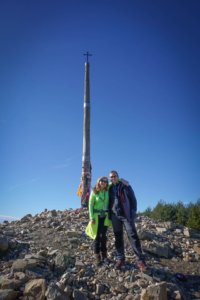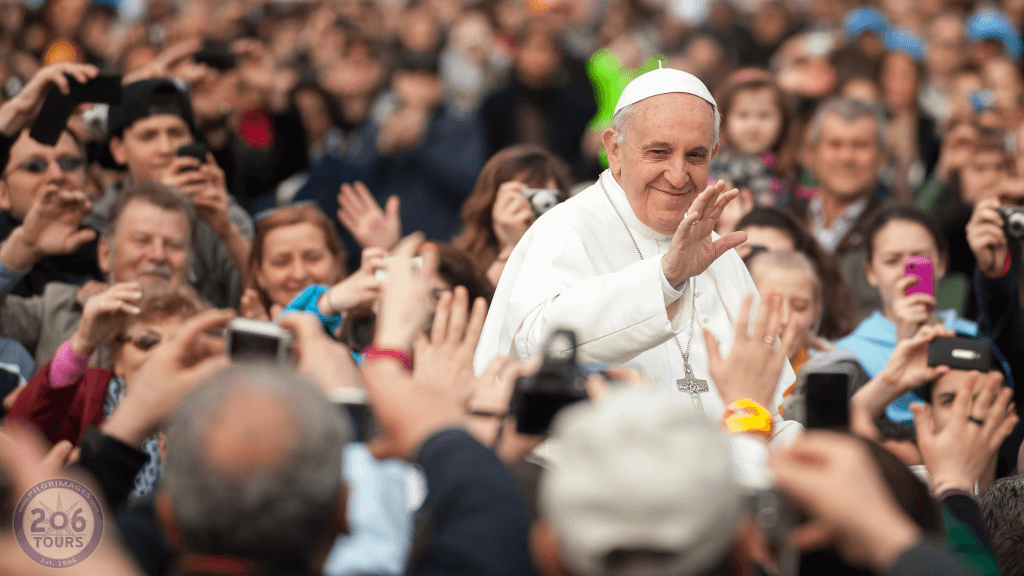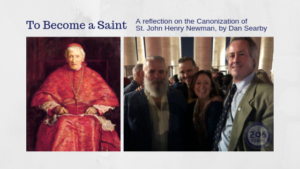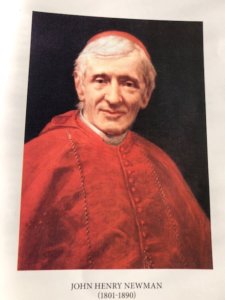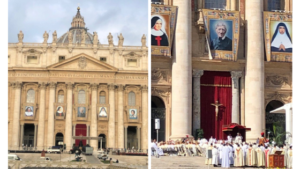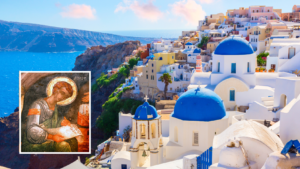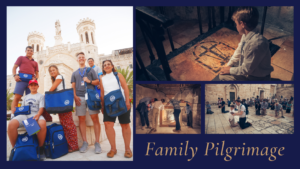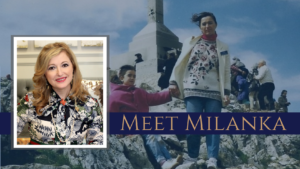Month: April 2020
In 2017 Milanka Lachman, President and Founder of 206 Tours, set out on a Pilgrimage on the El Camino trail, like millions of Pilgrims before her.
Here she is with our guide, Javier, the man who has made 206 Tours Pilgrimages “shine” in Western Europe for over 20 years! In the background is the Iron Cross, or “Cruz de Fierro”. The Iron Cross, is symbolic, as pilgrims leave a rock here, which they either carry from home or pick along the way – they leave it for God to take off their heavy burdens. There is a huge sundial to help pilgrims tell the time of the journey.
The origin of the cross is unknown, some say when the Cathedral of Santiago de Compostela was being built, pilgrims were asked to contribute by bringing a stone. It may have been erected to mark the road when it snows, others believe it is just a pile of stones called Montes de Mercurio, erected since Celtic times to mark strategic locations on the roads. There is a chapel dedicated to St. James
See more wonderful photos from the El Camino trail, here!
Make your own Pilgrimage in the Footsteps of St. James!
Find details on our El Camino Walking Pilgrimages, here.
Many people may not fully understand the deeply personal and religious nature of the act of pilgrimage. To some, taking a trip to Rome, Lourdes, or Medjugorje with your spouse, spiritual director, or parish may sound like an excuse to take a few days off from work, and experience a new culture and new foods. However, a pilgrimage is not a vacation.
Vacation is defined as “a period of suspension of work, study, or other activity, usually used for rest, recreation or travel”. On vacations, we relax, detach from our daily stressors, and treat ourselves to great foods, luxury, and fun activities.
A Pilgrimage, on the other hand, has a much different meaning. A Pilgrimage is defined as, “a journey, especially a long one, made to some sacred place as an act of religious devotion; as to pay homage.” A Pilgrimage is not a time for detachment, rest, or pampering, rather it is a time of deep reflection, modesty, and prayer.
In 2016 during the Jubilee of Mercy, Pope Francis delivered a speech containing his thoughts on the act of Pilgrimage to thousands of listening pilgrims in St. Peter’s Square. He said:
“A Pilgrimage is not the same as a Vacation… Making a Pilgrimage to shrines is one of the most eloquent expressions of the faith of God’s people… It would be a mistake to think that those who go on a pilgrimage live a spirituality that is not personal but rather of the masses. The reality is that the pilgrim carries within him his own history and faith and the lights and shadows of his own life. Each person carries within his or her heart a special wish and a particular prayer. Those who enter the shrine immediately feel they are at home, welcomed, understood, and supported.”
Clearly, a Pilgrimage is not a “break” from responsibilities like a vacation is – rather it is a calling; it reminds us of our responsibility to our faith as disciples of Jesus. On a Pilgrimage, we encounter God in the very places where He has revealed himself. A Pilgrimage is challenging – it takes us out of our comfort zone and can incorporate tedious travel or navigating difficult terrain. It is a transformational experience that changes lives and brings us closer to our faith in ways we could never imagine through sincere and concentrated prayer.
To share your own experience of how Pilgrimage has changed your life, email us at media@206tours.com
Written by Dan Searby, October 13, 2019
While you were sleeping last night, Blessed Cardinal John Henry Newman became Saint John Henry Newman, or as Pope Francis called him today, Ioanne Henrico Newman. The canonization ceremony took place at 10 am Sunday morning, Rome time.
French 19th and 20th-century novelist Leon Bloy once said: “The only tragedy in life is not to become a saint“. Cardinal Newman himself, when called saintly in an admirer’s correspondence said, “I have nothing of a saint about me… I may be well enough in my way but it is not the “high line“. History has judged otherwise, for Cardinal Newman lived out one of his other famous quotes, “To live is to change; to be perfect is to change often”.
Cardinal Newman is best known for leading the Oxford Movement that sought to restore the Catholic roots Anglicanism. When he followed his conscience and converted to Catholicism and 1845, it shook anti-Catholic England and he lost his post at Oxford and many of his friends. He continued to write prolifically and in 1879 was named Cardinal, a lovely grace note that is only topped by his now becoming a saint. He’s regarded as one of the greatest theologians of all time and many expect him to be named a Doctor of the Church. On a personal note, Cardinal Newman, and specifically his autobiography Apologia pro Vita Sua was a most powerful inspiration toward my own conversion.
Four others were canonized today, Roman Giuseppina Vannini (1859-1911), foundress of the Daughters of Saint Camillus (dedicated to serving the sick), Mariam Thresia Chiramel Mankidiyan (1876-1926), Indian born foundress of the Congregation of the Holy Family (ministering to families), Dulce Lopes Pontes (1914-1992) who served Brazil’s poor and sick and Marguerite Bays (1815-1879) a Swiss holy woman whose “life was linked to the suffering Christ”.
I had arrived in Rome mid-day Friday with transport and hotel nicely curated by 206 Tours. They had picked Starhotels Michelangelo (two thumbs up!) for its proximity to Vatican City, given a tight departure schedule Sunday. Had experienced a day and a half of its cultural, commercial and culinary pleasures. It’s my third trip here but few cities feel like they are so deep and that you have just scratched their surface with it’s myriad of neighborhoods, history and infinite number of stunningly beautiful churches whose richness that you almost grow numb to, like the last bite of a two pound lobster. Today was the raison d’etre and attending a canonization ceremony is a little like the New Year Eve’s experience at Time Square. You have to get there quite early and it is not for the faint of heart, or bladder, though the weather is much better.
I woke up around 5:20 am today, fixed myself a surprisingly serviceable Nescafe powdered cappuccino with an antediluvian hotel electric water warmer, and was out the door around 5:40 am. A coffee shop was providentially open, so stopped for a second cup to go and ran into a couple of English pilgrims on their way to Saint Peter’s Square; they were “Newman-heads”, like me.
The Michelangelo Hotel was a mere 5-minute walk to St. Peter’s where at 5:50 am, awaited an amoebic queue of about 100 folks, with the “doors” to open at 7 am, though nothing is ever on time in Italy, and they were late this morning also. The young English lady I had run into at the coffee shop joined me in line with her husband and father-in-law. Pippa, Henry and Russell, respectively, the couple from London and his Dad from traditionally Catholic Norfolk in East Anglia. Pippa is a music teacher and choir leader at a Catholic school in London. She is also an Anglican convert and we had an enjoyable early morning chat about “swimming the Tiber” and our faith journeys.
A massive crowd grew behind us and when the police came to the security checkpoints it began to shove forward. When the airport like screening finally opened up around 7:15 AM, it was like being in a rugby scrum and the four of us got separated. I got through and saved the four of us seats and saw Russell come in and waved him over and Henry and Pippa came in about 10 minutes later. She was pretty shaken by the jostling crowd and their shouting.
The sun rose above St. Peter’s Square and it was a glorious morning.
The time passed quickly and made for great people watching as the clerics from all over the world came into their reserved section in front of us, including, to use Pippa’s words, “Vicars with knickers”; meaning women Anglican priests. Was heartened by the Anglican presence honoring their alum which included a nattily clad Prince Charles who had a front-row seat on the big stage.
There were two priests whom I recognized and was able to say hello to, Father Joseph Scolaro, who grew up in my home parish of Saint Dominic’s, Oyster Bay and is now Pastor at Notre Dame in New Hyde Park. The other I had just met last week at a Catholic Near East Welfare Association (CNEWA) event, Msgr. David P. Charters, First Secretary to the Permanent Mission of the Holy See to the United Nations.
After being led in a Latin saying of the Glorious Mysteries of the Holy Rosary, the canonization Mass began at about 10:10 AM. Bishops and Cardinals and finally Pope Francis processed to the stage amidst great orchestral pomp and a beautiful chorus. That’s Good Pope Francis in the distance.
After the proclamation of Sainthood, the regular Mass liturgy followed. Pope Francis’ homily was in Italian so will need to get the translation. Hundreds of Priests uber-efficiently distributed communion. Saint Cardinal John Henry Newman’s famous poem/hymn Lead Kindly Light concluded the Mass around noon. I said goodbyes and got out ahead of the crowd to rush back to the hotel and catch a car to the airport, likely missing an up close glimpse of Pope Francis as he toured the square in the Pope-mobile. Got to the hotel in five minutes with the driver ready and waiting (thanks 206 Tours!).
Am now on an Alitalia flight home and am happily tired and clearly getting old as I have a friend who has become a Bishop and two of my heroes have since become saints (John Paul II the other). As I fly home a story comes to mind. There once was a farmer who had a beloved mule. He thought so highly of this mule that he attempted to enter it in the Kentucky Derby. He was told by the race officials that his mule did not have a chance against the thoroughbreds. He replied, “I suppose that’s true, but think of the mighty fine company he’ll keep“.
The faithful and the saints are mighty fine company to keep and I believe it rubs off on us. Many of you, especially you of the Royal Order of Melchizedek, have been my own spiritual inspirations, for which I say, thanks be to God! Amen.
[DISPLAY_ULTIMATE_SOCIAL_ICONS]
A Pilgrimage to Greece is a fantastic way to learn more about the life of St. Paul the Apostle and early Christianity. Here are a few of the sites you can visit from the life of St. Paul:
1. Philippi
Philippi was the city where Saint Paul the Apostle delivered his first sermon and where he established the first church in Europe. “And from there (He went) to Philippi, which is the leading city of the district of Macedonia and a Roman Colony. We remained in this city some days…” (Acts 16:12-18). Also, it is the site where Saint Paul baptized a woman named Lydia, the first convert to Christianity in Europe. The Roman Forum is where Saint Paul cast a spirit out of a fortune-telling woman. The prison (now in ruins) in which Saint Paul and Silas were thrown into by the owners of the fortune-tellers can still be visited here. The modern port city of Kavala, which was once the ancient Neapolis where Saint Paul, Silas, Luke and Timothy landed when they sailed into Europe.
2. Thessaloniki
In the winter of 49-50 A.D., Saint Paul wrote two epistles to the Thessalonians. These letters urged Christians to “live blamelessly” and to refrain from living idly while they wait for the second coming of Christ.
3. Athens
In Athens, visit Mars Hill where Saint Paul spoke to the Athenians about the one and only God (Acts 17:22).
4. Corinth
Ancient Corinth lies under the shadow of the towering Acropolis of Athens. Saint Paul lived in Corinth for two years. While here, he felt great grief over the way that the Gentile Church in Corinth had become. As a result, he was prompted to write four letters, all with the overarching theme of love. In Corinth, you will have the opportunity to view the site of Saint Paul’s trial by Gallio, as well as the remains of the first century shops, the Fountain of Peirene, and the Temple of Apollo.
5. Kusadasi & Ephesus
Head to Kusadasi to visit the small village of Mt. Koressos. While in this village, you will visit the small stone chapel that is situated upon the site where the Virgin Mary spent her last days following Christ’s crucifixion. Following this visit, your group will walk through the Magnesian Gate to the ancient Ephesus to visit the Great Theatre, the largest ancient theatre that had a capacity of 25,000 people and is a site where Saint Paul preached.
6. Heraklion
This morning you will awaken and transfer to the largest city on the island of Crete, Heraklion. While in this administrative capital, visit the ancient ruins of the Palace of Knossos. These ruins are the site where Saint Paul met the owner and captain of the ship who warned him of continuing his journey to spread Christianity in Rome.
Journey to Greece on a Catholic Pilgrimage in the footsteps of St. Paul
Greece: In the Footsteps of St. Paul with Greek Isle Cruise
Tour: 161
Destinations: Greece, Turkey
Duration: 11 days
A Family Pilgrimage is a beautiful experience for all ages! Bringing Children on a Pilgrimage can connect them forever with scripture in a way that will stay with them for the rest of their lives. A holy Pilgrimage will build the foundation for a strong relationship with Jesus, that children will carry with them every day.
Below, find some tips and ideas about bringing your children on a Pilgrimage.
Prepare and Pray:
To make the most of this Pilgrimage, we suggest you take time to prepare and pray with your child in the weeks before your trip. This will allow the child to fully understand the journey they are about to embark on. We recommend showing them maps, reading the itinerary together, and reading scripture or learning about Saints relating to the sites you will be visiting. Also, prepare them to experience a new culture by describing local food, delicacies, language, and traditions.
If you’re going to the Holy Land, give your child a children’s Bible that includes pictures ahead of the pilgrimage. When they get to the sites they have seen in their bible, they will recognize the place and connect it to the scripture. Realizing they are standing in the very spot they read about, will inspire them to say, “Aha, now I get it!”
The most important way to prepare for any pilgrimage, of course, is to pray. Praying together as a family is always powerful. It is especially powerful when it relates to a shared experience, like this trip you will all be taking together. Begin praying for your pilgrimage with special intentions – perhaps even encourage your children to keep a journal and write down, or even drawer, their prayers and petitions. Encourage them also to include other family members or friends by asking for special petitions and prayers.
Altar Serving:
While on Pilgrimage, you will celebrate Mass daily. If your child is an altar server, we encourage you to bring their black Altar server cassocks along.
Collect Memories:
A great way for your children to stay present and engaged throughout the tour, is by encouraging them to literally collect memories. Where available, have them collect maps, brochures, or prayer cards. Bring zip lock baggies for them to keep their “daily treasures”; rocks, shells, leaves, etc.
Things to bring:
A great thing to bring is 50 small coins for the children to contribute at masses and light candles. Giving them the coins at the start of the trip will give them a sense of independence as they use their own discretion on when and where to donate.
Also, bring a small rock that says “I love you Jesus” to leave in a prayerful spot is another great way to make children feel connected to a special stop on their pilgrimage.
Bring a notepad to draw pictures and write notes is also a great idea. Encourage your children to make notes or drawings for their fellow pilgrims, their guide, or to bring to a local Catholic school.
A family Pilgrimage will create stronger bonds within your family, as well as draw you nearer to Jesus and the communion of Saints!
Meet Milanka Lachman, DGCHS, President & Founder of 206 Tours
In 1985 Milanka Lachman founded 206 Tours at just 27 years old after a life-changing Pilgrimage to Medjugorje. While working for Yugoslav Airline in the early ’80s, Milanka began helping people travel to Medjugorje, which at the time was a very small village of just 300 people who opened their doors to the pilgrims that began to visit their beautiful village. After her experience, she felt called to create a company that could help others have transformational experiences as well. It was an incredible undertaking for a single mother of two with no money, no connections, no business experience, no knowledge of theology and no connections to clergy.
Milanka is happily married, has grown children and several grandchildren. She holds the title of Dame Grand Cross in the Equestrian Order of the Holy Sepulchre of Jerusalem and has built one of the nation’s leading Pilgrimage companies. Of the 460,000 Pilgrims who have traveled with 206 Tours, 63,000 of the pilgrimages were completed free of charge. Her strong leadership and faith have built a beautiful network of employees, partners, clergy, and pilgrims around the world who are keeping the act of pilgrimage alive and heralding prayer, reconciliation, and peace!
Learn more about Milanka & the 206 Tours Team here.

